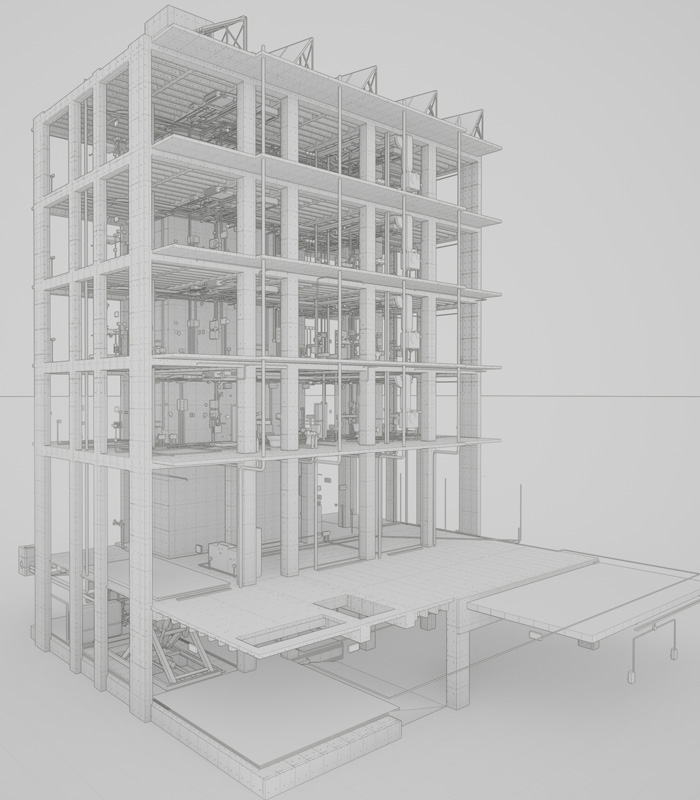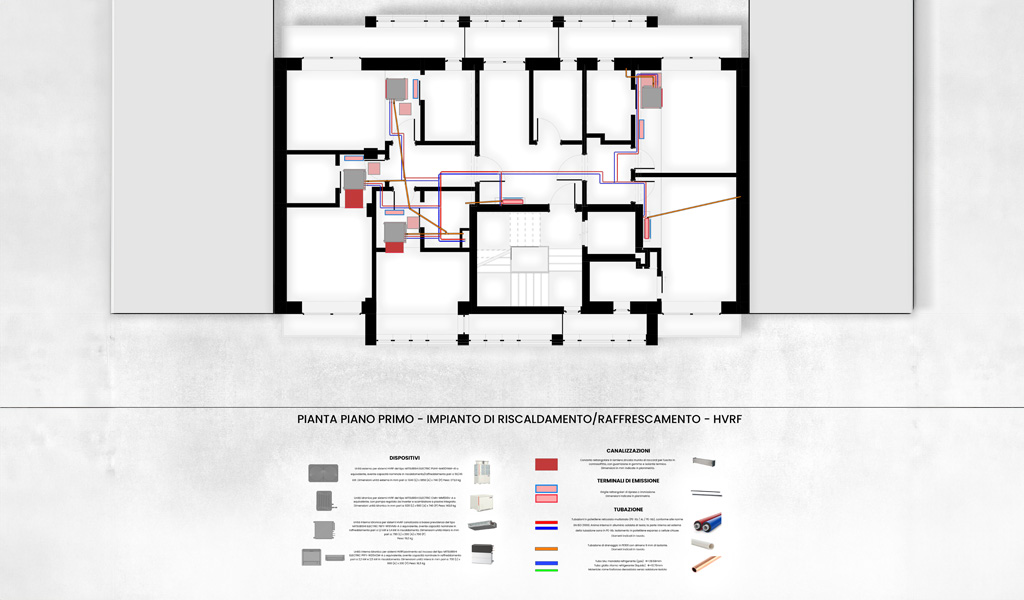Plant design and fire protection
This project involves the design of systems and fire protection for a newly constructed hotel in the Lingotto area of Turin.
Development of system design
The hotel will have a total of 23 rooms with associated services and will consist of a single building with 5 above-ground floors and one basement level.
To ensure customer comfort while also maintaining energy sustainability, various system solutions have been developed:
- Winter heating and summer air conditioning system;
- Controlled mechanical ventilation system;
- Domestic hot water production system with solar thermal integration;
- Pressurization system;
- Electrical system serving the structure;
- Photovoltaic system integrated with the electrical system;
- Water supply and sanitary systems;
- Wastewater disposal system;
- Fire protection system.
HVFR systems design
The installation of an HVRF (Hydronic Variable Refrigerant Flow) system is planned, consisting of an external unit and a hydronic unit. This will effectively distribute the thermal fluid (water) based on the operational modes of the internal units.
Emission will be via floor-mounted fan coils and medium-low pressure ducted units.
For the management of the HVRF, a control system with a 10.4” backlit color LCD touch screen will be installed. The system will be capable of managing up to 50 internal units/groups in a stand-alone configuration.
Domestic hot water production system with solar thermal integration
The project includes the installation of an air-water heat pump for domestic hot water production with a useful power of about 28 kW, a storage tank for DHW production with 800 liters solar integration, a solar thermal system, and a recirculation pump.
Pressurization system design
The planned system includes a high-efficiency compact pressure boosting unit capable of maintaining constant pressure through integrated speed modulation.
This system can self-regulate and constantly pressurize water to a predefined pressure.
The maximum flow rate, achieved by running the pump at the highest rotation speed, must guarantee the design flow rate. The minimum deliverable flow rate, instead, is equal to that of a pump at the minimum rotation speed.
The advantages of this type of system are:
- Maintaining pressure at nearly constant values;
- Compactness of the system and thus very reduced space requirements.
VMC system design
The controlled mechanical ventilation system ensures a continuous air exchange. This choice is essential to improve comfort and the healthiness of the environments. Exhaust air, loaded with carbon dioxide and humidity, is drawn in by the system and enters the heat recovery unit, where it transfers its thermal energy to the air taken from outside. The filtered air, once cooled or heated, is ready to be introduced into the indoor environments, while stale air is expelled outside.
Electrical and photovoltaic systems
The following works are planned:
- Creation of a new panel for connection to the supply provided by the electricity supplier;
- Creation of a new distribution panel serving the building, including supply mains with connection to floor panels;
- Creation of new floor panels, including conduits and ducts serving powered utilities;
- Creation of a new photovoltaic system with a power of 8 kWp, including electrical panels and ducts serving the system;
- Creation of an earthing system;
- Final checks and tests.
Water supply and sanitary systems
The installation of water supply and wastewater disposal systems is planned. The building is currently already supplied by the existing public pipeline.
The main distribution network, made with appropriately insulated multilayer pipes, will consist of 3 pipes: hot water, cold water, and a recirculation network that will ensure forced recirculation on specific days and times to prevent the formation of Legionella, a bacterium that develops at water temperatures between 25 and 42 °C.
The internal distribution in the building is carried out through mains running in the floor substructure and by supplying and installing collectors.
Fire protection systems
The activity will be carried out in compliance with current fire prevention regulations; in particular, the fire protection design has been developed according to the application of the RTV V5 of the Fire Prevention Code (D.M. 03.08.2015 and subsequent amendments), adopting the conforming solutions provided for hotels classified as PA (total number of beds 25<p≤ 50) and HB (fire height h 12<h ≤24 meters).
According to the Italian art.1 of D.M. 37/2008, the activity will be equipped with the following fire protection systems (letter g):
- Internal fire hydrant water network designed, installed, and maintained according to the main reference standards of good practice for fire water systems, in particular UNI 10779 and UNI EN 12845 standards.
- Automatic fire detection and manual alarm system designed, installed, and maintained according to the main reference standards of good practice for fire detection systems, in particular the UNI 9795 standard.
- Emergency voice alarm communication (EVAC) system designed, installed, and maintained according to the main reference standards of good practice, particularly the UNI ISO 7240-19 standard.




